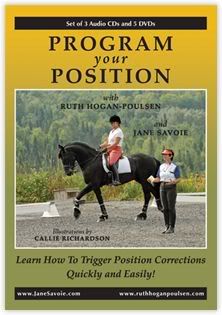Free Walk Q&A
How do I get a good free walk? Jane Savoie answers your questions
by Jane Savoie
What is the free walk?

The free walk is a gait of relaxation.
What should it look like?
• Your horse should lengthen his frame and lower his head and neck so he looks like he's going to graze. His poll is lower than his withers.
• He should open the angle at his throatlatch so his nose points a bit forward and he looks like he's stretching toward the bit.
• His strides become longer so he over-tracks to a greater degree.
How should you do the transition at the beginning of the free walk?
Preparation is the key to getting a good free walk. You should prepare for it the same way you prepare for the "stretchy" circle in the trot.
• Use a connecting half halt for three to four seconds on the short side while you're still in a medium walk.
• To give a connecting half halt, create energy by closing both calves as if you're asking for a lengthening, but don't let your horse lengthen. Instead, close your outside hand in a fist to capture, contain and recycle that energy back to the hind legs. (See January and February 2009 NWHS "In Plain English" articles for further instructions on the connecting half halt.)
• Keep your legs and outside hand closed for three to four seconds.
• While closing your legs and outside hand, vibrate or squeeze and release on your inside rein so your horse doesn't bend his neck to the outside.
• As you turn onto the diagonal, relax your legs and open your fingers so your horse can chew the reins out of your hands.
How should you do the transition back to the medium walk?
Use the same connecting half halt you used to prepare for the free walk.
• While the reins are still long, press lightly with your calves.
• As you shorten the reins, keep your new outside hand closed in a fist and squeeze and release with your new inside hand.
What if your horse is lazy?
If your horse doesn't march with good energy, "breathe" your legs during the free walk. To breathe your legs:
• Take your legs off of his sides.
• Move them an inch or two back
• Then, place them on lightly again
Breathing your legs does two things: if you've been gripping, your horse is probably numb to your legs. Taking your legs off allows you to put them on again lightly so he feels them. Moving your legs back also puts them closer to your horse's "engine" and reminds him to use his hind legs actively.
What if your horse wants to jig?
If your horse wants to jig, do several transitions into the halt.
• Praise your horse after each halt. Soon he'll learn to anticipate stopping or slowing down.
• Then you can use just a little bit of your "stopping aids" to remind him to stay in a four-beat flat-footed walk as you make your way across the diagonal.
If he tends to jig when you pick up the reins at the end of the diagonal, halt first. Then, pick up the reins in the halt. Doing so will train him to stay slow when you do the transition for real.
This article originally appeared at ezinearticles.com. Reprinted with permission.
Labels: April 2009, In Plain English, jane savoie



0 Comments:
Post a Comment
Subscribe to Post Comments [Atom]
<< Home